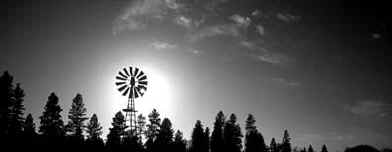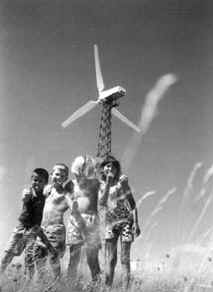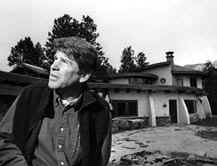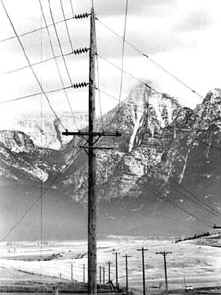GREEN POWER
The
Winds of Change

By Ken Picard � Photos by Chad Harder
Reprinted with permission from the Missoula
Independent
Can Montana lead the way in the alternative energy revolution?
Perched on the crest of a hill at the foot of the snow-capped Mission Mountains
is a cluster of homes unlike virtually any other in Montana. The four houses and
a barn bear the unmistakable signature of high-style and affluence: the large
bay windows that capture the breathtaking vista of the jagged peaks to the south,
the hand-peeled birch baluster that spirals into a living room and kitchen dug
partly into the side of the mountain, the multi-colored slate shingles that seem
to be hewn from the very stone of the mountains they emulate.
Yet something is noticeably absent
from this idyllic picture, a detail the eye captures first but the mind is slow
to register. No overhead wires traverse the tree line, no utility boxes cling
like koalas to power poles, no spinning meters count the inexorable flow of electrons
that keep refrigerators humming and electric lights glowing. This entire complex,
a veritable model of resource conservation and energy efficiency-from its salvaged
timber beams to its ultraviolet lights that purify the potable water supply-is
powered entirely on solar and wind energy.
For the owners of this remote hideaway
(who asked to remain anonymous), the decision to stay independent of the utility
grid was based as much on economic as philosophical grounds. At a cost of nearly
$50,000 per mile to run power lines to this spot, the owners chose instead to
invest in what promises to be the premier emergent technologies of the first decade
of the 21st century: green energy.
Standing some 50 feet above the
main house is a small wind turbine, whose lazy rotation on this calm April afternoon
is barely discernible. Operating more efficiently is the 22-foot-by-42-foot solar
array that pulls double-duty as roof shingles for the barn. Even under an overcast
sky, the seven-kilowatt system is generating enough electricity to meet the consumption
needs of the four structures: household appliances, water heaters, pumps to pressurize
water lines, and anything else the residents have plugged in.
"Basically it's a miniature
city," says Missoula builder Steve Loken, who spent nearly three years constructing
these homes outside of St. Ignatius. "They have all the things you have in
a city, except on a much smaller scale: pressurized water lines, a well, sewage
waste water treatment, electricity generation."
Obviously, such freedom from the
grid doesn't come cheap. Loken won't divulge exactly how much this system costs,
except to say that "It's not for the faint-hearted."
Still, while this closed loop of
energy generation operates high above the Mission Valley floor, its technology
is anything but pie-in-the-sky. As Loken puts it, "Anyone can do this. It's
not that challenging or difficult. At a more affordable scale, much of this can
be done. It's just conservation of energy and renewables."
The American Wind Energy Association
ranks Montana as fifth in the nation for potential wind generation. Still, Montana
generates less than 0.5 percent of its energy from wind. In Browning, four 10-kilowatt
turbines provide 25-35 percent of the energy used by the city's waste treatment
facility.
The Green Energy Revolution
 On
this, the 30th anniversary of Earth Day, Montana and the rest of the nation stand
on the brink of an alternative energy revolution. During the 1990s, solar energy,
the world's second fastest-growing energy source, ballooned an annual rate of
16 percent and is poised to explode into the mass market within the next ten years.
Also known as photovoltaics (or "PV"), solar energy was for years seen
as an unreliable, if promising novelty, reserved for NASA space probes, rich eccentrics
and free pocket calculators. Today, PV is a mature, proven technology, in use
at hundreds of sites throughout Montana. On
this, the 30th anniversary of Earth Day, Montana and the rest of the nation stand
on the brink of an alternative energy revolution. During the 1990s, solar energy,
the world's second fastest-growing energy source, ballooned an annual rate of
16 percent and is poised to explode into the mass market within the next ten years.
Also known as photovoltaics (or "PV"), solar energy was for years seen
as an unreliable, if promising novelty, reserved for NASA space probes, rich eccentrics
and free pocket calculators. Today, PV is a mature, proven technology, in use
at hundreds of sites throughout Montana.
But the biggest storm of the decade
was clearly wind generation, now the world's fastest-growing source of energy.
Expanding at a mind-blowing pace of 30 percent annually (and even faster in 1999),
the wind technology industry is expected to become cost competitive with even
the cheapest fossil fuel energy sources by 2010. A study released this month by
the Olympia, Wash.,-based firm, Climate Solutions, notes that wind generation
could provide 10 percent of the world's electricity needs by 2020, exceeding Europe's
current total electricity consumption.
Concerns about global warming and
the proliferation of greenhouse gases, acid rain, resource degradation, and reliance
on foreign oil are all fueling a burgeoning interest, research and financial investment
in clean, renewable energy sources. Meanwhile, in Montana, utility restructuring
is literally reshaping the way energy will be generated, transmitted and distributed
in the 21st century.
So how is Montana positioned to
capitalize on this race toward green energy? According to the National Center
for Appropriate Technology, Montana has an abundant solar resource that can be
tapped easily for residential and commercial uses, farming, ranching, recreation
and a host of other industrial uses.
And yet, we have only the vaguest
notion of how many solar electric systems are now in use in Montana. Thus far
there has been no coordinated effort at the state level to either track or encourage
the use of solar energy. This is indeed unfortunate, because until the price of
photovoltaic systems drops considerably, driven down by the economy of scale,
the market for PV systems will remain largely dependent upon federal subsidies
and tax breaks, or else reserved for the wealthy few who can afford to make a
considerable up-front investment.
The case for wind generation in
Montana is perhaps even more dramatic. Ask anyone in western Montana about wind
generation and they're likely to mention the handful of wind turbines that were
built in Livingston in the 1970s and 1980s, or more locally, the now-defunct Moriah
Power windmill that spins lazily on the Highway 93 roadside in the Bitterroot
Valley.
The fact is, the American Wind
Energy Association ranks Montana fifth in the nation for possible wind energy
generation, with the potential to generate an estimated 1 trillion kilowatt-hours
of electricity annually. Patrick Mazza, author of the Climate Solutions report,
"Accelerating the Clean Energy Revolution," calls Montana "a Saudi
Arabia of the breeze [that] could reliably supply 116,000 megawatts, [or] 15 percent
of U.S. electrical demands."
In 1998 alone, more than 230 megawatts
of new wind capacity were installed in the United States, none of which occurred
in Montana. This is staggering, when you consider that our closest neighbors -
Washington, Oregon, Wyoming and North Dakota-are all forging ahead with ambitious
wind generation projects. In Iowa, whose economy is similar to that of Montana,
the wind industry generates $2 million per year in tax payments to counties and
school districts, $640,000 per year in direct lease payments to landowners and
created 200 construction jobs in 1999 alone.
In environmental measures, that's
382,094 tons of coal that Iowa will not burn for electricity this year, 1.3 billion
pounds of greenhouse gases that will not be released into the environment, and
646 million kilowatt-hours of pollution-free energy, enough to serve the needs
of 66,204 residential customers.
Surprisingly, except for one wind-powered
waste treatment facility located in Browning, there are few, if any, utility-grade
wind turbines operating in Montana. Again, no state agency tracks wind generation
projects or actively encourages the technologies that could tap this abundant
resource. The Montana Department of Environmental Quality, which dedicates considerable
time and resources to monitoring the state's fossil fuel industry, devotes next
to nothing to Montana's immense alternative energy potential.
Part of the problem, of course,
has been lack of motivation. Historically, Montana has enjoyed low-cost electricity
that depends upon resources found in our own backyard. As the nation's sixth-largest
net generator of hydroelectric power, we get 52 percent of our electricity from
a network of hydroelectric dams. As the seventh-largest coal producing state,
Montana meets 48 percent of its electricity needs from coal-fired plants. In contrast,
solar and wind generation make up less than one percent combined.
Has Montana fallen hopelessly behind
the green energy curve? Probably not, although we have some real catching up to
do. In 1997 the Montana Legislature approved the Universal System Benefits Charge
(USBC), which in 1999 collected about $8.5 million from utility customers to promote
alternative energy programs, conservation, low-income customer billing assistance
and weatherization.
Other efforts underway to bring
Montana into the alternative energy mainstream include a Montana Wind Symposium
scheduled for early this summer at Montana State University, which will look into
ways of promoting wind generation development. The Montana Solar Initiative, a
partner of the Clinton Administration's 1997 Million Solar Roofs Initiative, has
already brought together representatives from the utilities industry, electricity
cooperatives, solar business owners and environmentalists to meet its goal of
installing 1,000 solar systems on rooftops throughout Montana by 2010. Sweeping
changes are in the air, and they're not all happening on remote Montana hillsides.
Shine On, You Crazy Diamond
Amid the organized chaos in the
yard of the Missoula Urban Demonstration Project on Missoula's Northside, volunteers
are laying the groundwork for what may be one of MUD's largest and most ambitious
projects to date: the renovation of its main office and the installation of a
264-panel solar array, donated from PV system manufacturer Atlantis Energy. The
project, funded by a $22,369 grant from the Montana Power Company and being installed
by Solar Plexus of Missoula, will turn the roofs of MUD's existing house and a
soon-to-be reconstructed railroad worker shack into solar energy collectors. When
the panels are fully installed by the end of May, the system will produce about
3,000 watts of electricity, reducing MUD's utility bill by an estimated 75-80
percent annually.
Like the St. Ignatius homes (where,
coincidentally, the donated solar panels were first put into use) the MUD renovation
will also incorporate passive solar designs to make the house more energy efficient.
For example, all living spaces will be situated on the south side of the building,
where energy efficient windows will gather the heat of the day during the winter
and reflect it during the summer. Likewise, a south-facing "water wall"
composed of one-gallon olive oil cans filled with water will collect heat during
the day and conduct it into the house at night.
The PV system itself will be intertied
to the utility grid through a process known as "net metering," whereby
any excess solar energy generated is fed back into the power grid, thus running
the meter backward and earning the customer credit.
Similar demonstration projects
will soon be underway throughout Montana. In the next month or so, the National
Center for Appropriate Technology (NCAT) will announce the winners of the "Sun4Schools"
Project, a program that will install three- to four-kilowatt PV systems this summer
in 12 middle schools or high schools across Montana. Like the MUD project, the
school PV systems will be net metered and are expected to generate about 6,500
kilowatt-hours of electricity annually to supplement the schools' energy needs,
eliminating the emission of more than 7,000 pounds of carbon dioxide and nearly
two pounds of nitrogen oxides each year. At least one of those schools will be
in the Missoula Valley, and several are in the Bitterroot.
Such demonstration projects are
all well and good at raising public awareness of solar energy's potential, but
even solar's most ardent supporters admit that it may be years before solar energy
is cost-competitive with fossil fuel and hydroelectric sources. So how much interest
is there already among Montana consumers to invest in it?
Plenty, says NCAT's Dale Horton.
In March, NCAT ran advertisements in newspapers across the state, offering to
subsidize the cost of 20 to 30 one-kilowatt residential PV systems. Although the
solar systems usually run about $13,000 each, homeowners would only have to invest
$3,000 to have one installed. The response? In one week, NCAT received 650 requests
for applications.
"That means that there are
at least 650 people out there who are interested in spending $3,000 of their own
money to have a solar system on their house that would only provide a part of
their energy needs," says Horton. "That, to me, suggests that folks
place a high value on energy produced by the sun or clean energy resources."
Though Horton speaks optimistically
about the future of solar energy, he admits that these demonstration projects
do more to lay the foundation for Montana's renewable energy industry by helping
to reduce future costs, rather than providing any immediate economic benefits.
"I would hate for people to
believe that solar energy is now cost-effective for the average Montana Power
customer," he says. "Clearly, it is not."
Horton also cautions against falling
into the trap of enacting energy policies like those of the 1970s, when one-time
federal tax credits caused solar businesses in Montana to become "a flash
in the pan," only to disappear a few years later once the tax credits dried
up.
That said, solar energy holds the
potential to not only transform Montana's energy usage, but also to provide the
state's economy with a clean industry that has a ready-made international market.
As Horton points out, three-fourths of the PV systems manufactured in the United
States are sold overseas, primarily to developing nations, where it is often cheaper
to install remote solar generators than to invest in centralized power plants
and miles of transmission lines. Creating a strong domestic market for solar products
also ensures that American solar companies remains competitive with their European
and Asian counterparts.
"Technology has given us photovoltaics.
We can now plant our butts anywhere we want on the edge of any wilderness area
in the world," says Missoula builder Steve Loken. "But you know what?
Everything's got parts. Parts have to come from trucks, trucks have to come from
central distribution and have to be manufactured in Taiwan. Nobody's off the grid.
We're all in a global village."
Answers Blowin' in the Wind
 In
1991, on a open stretch of highway outside of Browning, Martin Wilde, then living
in Columbus, Ohio, made an interesting discovery that changed the direction of
his life. In
1991, on a open stretch of highway outside of Browning, Martin Wilde, then living
in Columbus, Ohio, made an interesting discovery that changed the direction of
his life.
"I was out here driving and
I felt this power ripping at my rental car," says Wilde. "And I thought,
'Gee, someone ought to do something with this here.'"
Five years later, Wilde had installed
the first utility-scale wind turbine on Indian land in Montana. Today, thanks
to a grant from the U.S. Department of Energy, the Blackfeet Tribe, Glacier Electric
Cooperative and the City of Browning, four 10-kilowatt turbines provide about
25-35 percent of the energy needs for Browning's waste treatment facility, which
comes to about $2,000 to $3,000 per month.
According to Wilde, now the project's
manager, the wind turbines have been functioning just as he expected them to,
without any of the problems that plagued some of the Livingston turbines, which
either blew down or froze up in the bitter cold of Montana winters. Nor, he says,
have there been any noise complaints or conflicts with wildlife. If wind generation
has earned any bad reputation at all, says Wilde, it likely comes from Altamont
Pass in southern California, where "unbridled, irresponsible development,
fueled by unrealistic economics" led to dozens of wind projects littering
the countryside, tragically, as was later discovered, along a major flyway for
birds.
In short, says Wilde, for the Blackfeet
Reservation, where alcoholism and unemployment are more common than economic opportunity,
the Browning wind project has been a real success story. Again, he admits that
it's a more of a demonstration project to promote wind technology rather than
a true example of the large-scale commercial potential of wind energy in this
region.
"Putting a windmill up next
to something that uses a lot of electricity is a meaningful, significant and easy-to-do
project," says Wilde. "To put up a bunch of windmills a thousand miles
away from where you're going to use the power is not so easy to do."
"Probably the biggest hindrance
[to wind generation in Montana] is that people claim it's very cost-ineffective,"
says Great Falls rancher Richard Liebert, who has been exploring the possibility
of starting wind generation cooperatives to boost the incomes of Montana's farmers
and ranchers. "It costs two to three times more to generate power from wind.
Well, that's true, but nobody thought about the cost of hydroelectric power before
we started investing in dams. And that wasn't all built with private money, I'll
tell you that."
Liebert, who recalls the days when
every farmer and rancher had a small windmill on his property, says he's been
frustrated in his efforts to find anyone at the state level interested in making
his vision a reality .
"It's ironic that we have
all these windmills that pull up water and power little radios and did so much
for plumbing, and we can't go ahead with the tried-and-true technology that we
relied upon so much in the last century," says Liebert. "Nobody's leading
the charge. It's just incredible. It's like an idea that was stillborn."
Will images like this be a thing
of the past one day? Experts predict that "distributed generation"�replacing
large, centralized power plants with small, decentralized generators like wind
turbines and rooftop solar arrays-could redefine how electricity is generated,
sold and distributed.
The End of Grid Lock?
 These
are, indeed, uncertain times for electricity generation and distribution in Montana.
When the Montana Legislature enacted the Electric Utility Industry Restructuring
and Customer Choice Act in 1997, allowing customers to choose which company supplies
their electricity, no one foresaw that the Montana Power Company, the state's
largest utility, would opt to get out of the electricity business. These
are, indeed, uncertain times for electricity generation and distribution in Montana.
When the Montana Legislature enacted the Electric Utility Industry Restructuring
and Customer Choice Act in 1997, allowing customers to choose which company supplies
their electricity, no one foresaw that the Montana Power Company, the state's
largest utility, would opt to get out of the electricity business.
But this uncertainty also brings
unprecedented opportunity for innovation, not only in the technologies we rely
upon for generating electricity, but also in how electricity is sold and distributed.
Green energy like wind and solar hold the key to radically redefine what utilities
are and, excuse the pun, who holds the power.
The days of vertically integrated
utilities, where a monopoly owned all the resources-from the coal in the ground
that fired the generation plant to the power line that ran into your house-may
soon be a thing of the past. As NCAT's Horton explains, alternative energy offers
the potential for what's known as "distributed generation." Instead
of the traditional system in which electricity is generated at a centralized location
and fed in one direction to consumers over power lines, distributed generation
allows small generation units, like rooftop solar arrays, small wind turbines
and fuel cells, to be dispersed across the grid, with electricity flowing in many
directions at once. This model that bears a remarkable resemblance to the paradigm
shift that occurred in the communications industry, with the advent of the Internet.
"This will be revolutionary,"
says Horton. "People thought restructuring was going to change the electric
utility industry. Restructuring will look like a small blip compared to what distributed
generation will mean. Who controls it? Who makes the rules? Who sets the rates?"
The revolution, it appears, has
already begun. In Pennsylvania a company call Green Mountain is leasing roofs
from K-Mart and other buildings with flat roofs, installing photovoltaic panels
and calling themselves a solar utility. It's estimated that the typical box store,
with a 100,000-square-foot roof, is capable of producing more than a megawatt
of solar electricity. One can only imagine the potential energy that could be
recouped on Reserve Street.
That Montana will be swept up in
this alternative energy revolution is all but a certainty. The question remains
whether we will be a major player, or left blowing in the breeze.
Missoula
Independent photos by Chad Harder
|